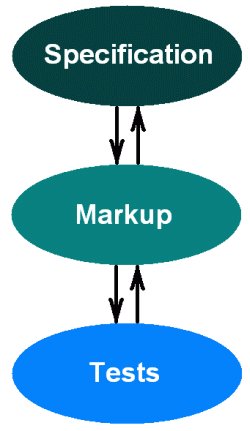Assertions and markup

It is very important to have a good process while writing the test suite. I will talk about the one that was used for JLS.
As mentioned before the final product is the number of tests. There is a relation between the tests and the specification. The assertion-driven process gives an idea of what each group of tests actually checks in the specification. Using this relation the developer can calculate the coverage, get the list of assertions on which the tests were not written, etc.
Assertion is a statement from a specification that can be tested. And the first step is to identify all assertions in the specification. After that the developer can write tests.
Example of assertions from the Java Language Specification:
- A compile-time error occurs if the same modifier appears more than once in an interface declaration.
- The binary name of a member type consists of the binary name of its immediately enclosing type, followed by $, followed by the simple name of the member.
- A continue statement may occur only in a while, do, or for statement.
There could be many statements that are non-testable or involve uncertainty. Sometimes such statements include words like “possible” or “maybe”. It is not true that if a sentence has a word “may” it is not testable, but usually it is so.
Examples of non-testable statements:
- We do not recommend such “mixed notation” for array declarations.
- Situations where the class of an object is not statically known may lead to run-time type errors.
- If, however, evaluation of an expression throws an exception, then the expression is said to complete abruptly.
There are many discussions and disputes about assertions. Some say that examples should not be treated as assertions. Others say that each statement is an assertions and there are two kinds of them: testable and non-testable. My personal opinion is that an assertion is certainly something testable. And in most cases examples are assertions just because the test can be written checking the particular example.
The process of identifying assertions in the specification is called markup. There are many approaches. But in any case the user must be able to get information on whether the statement is an assertion and somehow distinguish one assertion from another. There could be a separate repository with mapping of assertions and their id’s to statements. I like the idea of integrating the markup into the specification. This approach was chosen for the language area of the Java SE test suite. The JLS was written in FrameMaker. With export mechanisms the PDF and HTML versions were created. The html version was used during the creation of the test suite.
In JLS and JLS 2 some special anchors identified the beginning and the end of an assertion. Additional information was the assertionID and short summary of the statement. The end anchor was an image and a link to the test. The html view and the code view are shown on the corresponding illustrations. The assertion id’s are arr033, arr034, arr020, etc.
The general idea can be described as:
<a name=assertionID><!– shord description as html comment –>
assertion statement here
<img src=”pics/assert.gif”><a href=”path to test”>test ID which is the same as assertion ID</a>
If seperate statements in different parts of specification are tested by one test the first tag will be something like arr033_0, arr033_1, arr033_2.
This kind of architecture was used for JLS and JLS 2. It was slightly modified for JLS3, but the main idea was kept. I know some examples of approaches with non-static assertion IDs kept in a separate repository, where ID is some hash-value calculated based on the content. For several reasons it showed up to be not a very good solution. There is always a hard process migrating to the new version of the specification. But in my opinion it is much easier with the static ID’s embedded into the specification.
anchor, assertion, assertionID, FrameMaker, Java, Java Language, Java Language Specification, Java SE, JDK, JDK6, JDK7, JLS, language, markup, PDF, spec, specification, statement, tests